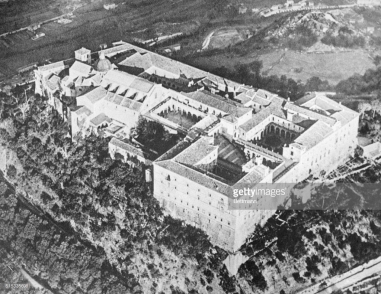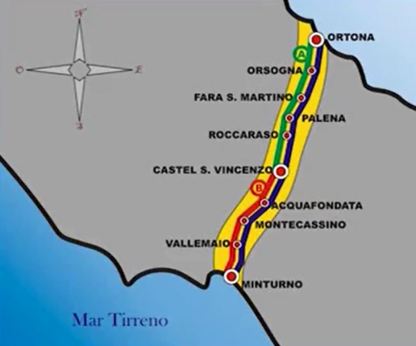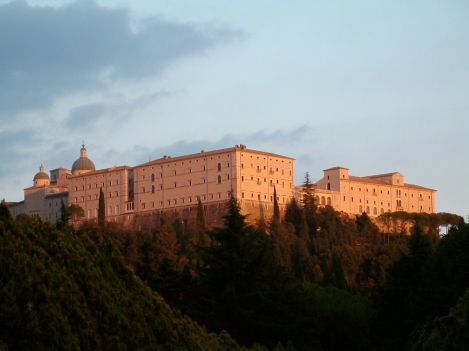Monte Cassino and the Destruction of Historical Sites

Is it ever permissible to destroy a site or building of historical value because of possible military applications? The damage done by insurgents, jihadis, rebels, governments and western forces in the Middle East over the previous two decades provides plenty of more recent examples, but instead I have chosen to look at a contentious episode from the Second World War – the Allied bombing of the ancient abbey of Monte Cassino.
By early 1944, the Allied invasion of Italy had lost momentum. Mountainous terrain combined with winter weather and the well-prepared defences of the German commander, Field Marshal Albert Kesselring, had reduced the two-pronged Allied attack to a slow and at times murderous crawl. Pressure to break through Kesselring’s Gustav Line was increased by the Allied landings at Anzio in late January, over 60 miles behind the German defensive line and a mere 35 miles from Rome. The Germans had quickly encircled the Anzio beachhead and without proper reinforcement Major-General John Lucas’ US VI Corps faced being grounded out of existence by the larger German Fourteenth Army of General Mackensen.

Kesselring, Clark, Vietinghoff, Freyberg and Alexander
This brought the showdown between General Mark Clark’s US Fifth Army and General Vietinghoff’s German Tenth Army around the small town of Cassino into sharp focus. Of particular interest was the hill that overlooked the town, Monte Cassino, as its heights afford an excellent view of the valley below, so any Allied attempts to move on the town would have been under intense scrutiny from any German forces on the hill.
That in itself constituted enough of a military problem for the Allies as the German Gustav Line incorporated much of the surrounding area. However, what makes this whole affair so contentious is that on top of Monte Cassino stood a vast Benedictine monastery.

First settled in the fifth century BC, Cassino was a stronghold of the Volsci of central Italy. It was they who established the first lookout/citadel at the summit of Monte Cassino. The town became Casinum following the Roman defeat of the Volsci in 312BC and a temple of Apollo was erected at the former Volscian citadel. Archaeological digs have found evidence of the Roman presence on Monte Cassino, although no remains of the temple have yet to be discovered. This would not be all that surprising for despite being near the very centre of the Roman Empire, Monte Cassino had not been free from violence. The collapse of western Roman territorial integrity in the fifth century exposed central Italy to the degradations of Huns, Goths, Vandals and other Germanic tribesmen. This meant that by the 520s Cassino had been almost completely abandoned by the time St Benedict of Nursia arrived to found the monastery of Monte Cassino.

Despite having become a bishopric seat, Pope Gregory I claimed that the area including Cassino was still largely pagan by the early sixth century (Pope Gregory I, The Life of Saint Benedict VII.10-11), although it has been pointed out that it is common place for in such hagiographies for the saintly protagonist to have to deal with the presence of paganism and demonic interference (Christie (2006), 113), so it may be more a literary topos with Gregory following in the footsteps of Sulpicius Severus’ Life of St Martin and even the Biblical story of the Israelites entering the Holy Land (Exodus 34:12-14). It may well be instead that Benedict found the temple/citadel on Monte Cassino deserted but still with some surviving pagan artefacts, sculptures and buildings. His smashing of statues and altars was possibly more of a gentle conversion to chapels to St Martin and St John the Baptist.

At Monte Cassino, Benedict compiled the Benedictine Rule that became the founding principle for western monasticism, advocating that monks pray, work and care for the sick, with the monastery containing what is considered to be the first hospital in Europe to achieve the latter precept. The growth of the Monte Cassino hospital necessitated a constant search for new medical knowledge, so the monks obtained as many books as they could find, establishing what would become the world’s finest medical science library by the 10th century.

Such was the rapid growth in reputation for Monte Cassino that it not only drew physicians from around the Mediterranean, but also famous religionists and political leaders. In around 543, Totila, king of the Goths, came to visit Benedict; during the 8th century it was home to both Paul the Deacon, historian of the Lombards, and Carloman, the eldest son of Charles Martel, the Frankish victor at the Battle of Tours and therefore uncle of Charlemagne. Carloman was one of several prominent men to be laid to rest at the monastery along with St Benedict. Another was the man responsible for Monte Cassino achieving its peak fame in the 11th century, the abbot Desiderius, who later became Pope Victor III.

Unfortunately, the growth in spiritual and medical reputation of Monte Cassino and its Benedictine monks could not divest it of its prominent strategic location. A generation after St Benedict’s death, the Lombards sacked the abbey in 581/589, leading to its abandonment for over a century. Even the body of Benedict reputedly removed to Fleury Abbey, in modern Saint-Benoit-sur-Loire near Orleans, France. The seemingly benevolent donation of lands around Cassino to the monastery by Gisulf II in 744 may be more about taking advantage of the strategic position of Monte Cassino as a buffer between the Lombard principality of Benevento and remaining Roman lands in southern Italy. In 884, the area came under attack from Saracen raiders, who burned the monastery, and it would be sacked again in 1799 by the forces of Napoleon Bonaparte.

That near millennium gap between sacks may reflect the growing reputation and stature of Monte Cassino; however, it may also highlight the ups and downs of the monastery as an institution and an edifice. A major rebuild in the 11th century under Desiderius saw to it that the site was no longer just the twin chapels and hospital of Benedict’s day, but for all the Italian and Contantinopolitan splendour this rebuild brought, the incorporation of Monte Cassino as a cathedral by Pope John XXII in 1321 and an earthquake of 1349 marked a period of steady decline. With the dissolution of the Italian monasteries in 1866, Monte Cassino would be classed as a national monument. This chequered history does not mean that the monastery had fallen into complete disrepair; far from it. Indeed, it would be the continued strength of much of the masonry as well as its strategic position which was to play a significant role in that fateful decision of 15 February 1944.

Building the defensive lines against the Allied invasion of Italy, Field Marshal Kesselring had ordered German units not to include the monastery itself as part of the Gustav Line because of its historical significance and had informed the Allies thus. However, the Allied commander of the New Zealand II Corps that was to form the spearhead of the attempt to relieve Anzio, Lieutenant-General Sir Bernard Freyberg, along with Major-General F.S. Tuker, whose Indian 4th Division would lead any attempt on the hill, felt that the monastery posed a major threat to Allied interests should the Germans occupy it. One officer stated that “Wherever you went, there was the monastery, looking at you…”

Freyberg’s initial request for an aerial bombardment of the monastery was rejected by General Clark, who suggested that not only did such an act contravene an existing agreement with Kesselring but the monastery had become a refuge for many of the inhabitants of Cassino itself. The killing of innocents would hand the Germans a propaganda victory that Hitler’s master manipulator Joseph Goebbels would exploit to the fullest. However, Clark’s most important argument from a military standpoint was that turning the monastery into rubble would create even stronger fortifications for the Germans, who would undoubtedly occupy the monastery once the Allies had bombed it.
Reconnaissance aircraft were sent for a low-altitude pass and brought back contrasting reports. Lieutenant-Generals I.C. Eaker and J.L. Devers, backed by the British and American press, claimed to have seen “a radio mast […] German uniforms hanging on a clothesline in the abbey courtyard; [and] machine gun emplacements 50 yards (46 m) from the abbey walls.” (Hapgood and Richardson (2002), 161, 185). Conversely, Major-General Geoffrey Keyes of U.S. II Corps, who flew over Monte Cassino several times, reported that he had seen no evidence of a German presence. When informed of others’ claims of having seen enemy troops there, he stated: “They’ve been looking so long they’re seeing things.” (Hapgood and Richardson (2002), 169)
Major-General Kippenberger of the New Zealand Corps HQ opined that the Germans were probably using the hill itself to observe the Allies, even if there was no evidence for it. Cutting right to the source of the problem and ignoring any agreement over the status of the monastery and its historical significance, Kippenberger also stated that once the fighting broke out, it would be very likely that the Germans would in some way use Monte Cassino as a shelter or staging ground. It would be just too tempting not to…
“Undamaged it was a perfect shelter but with its narrow windows and level profiles an unsatisfactory fighting position. Smashed by bombing it was a jagged heap of broken masonry and debris open to effective fire from guns, mortars and strafing planes as well as being a death trap if bombed again. On the whole I thought it would be more useful to the Germans if we left it unbombed.” (Majdalany (1957), 121-122)

Tuker made his own more historiographical survey of the monastery. Lacking clear and detailed intelligence of the make up of the monastery, Tuker reputedly resorted to a book he found in a Naples bookshop dated to 1879 about the construction of Monte Cassino. In a subsequent memorandum to Freyberg, he concluded that should the monastery been targeted for destruction to prevent or oust German occupation, the sheer extent of the masonry would require more drastic action than field engineers and normal bombs. The 150 foot tall and 10 foot wide walls caused particular concern with Tuker claiming that the usual 1,000 pound bombs would be “next to useless” (Majdalany (1957), 114-115). It was Tuker’s opinion that any attack on the German placements within the monastery would only be successful if “the garrison was reduced to helpless lunacy by sheer unending pounding for days and nights by air and artillery,” (Holmes (2001), 113) which would only be achieved by the use of some of the most powerful ‘blockbuster’ bombs available to the Allied Air Force at the time.
Faced with this conundrum of potential German occupation of such a strategic sight, current or future, a gentleman’s agreement with Kesselring, and civilians taking refuge within the historic monastery, the Allied commander-in-chief for Italy, General Sir Harold Alexander, chose to err on the side of military caution. Not willing to take the chance that the Germans were already in the monastery, Alexander authorised Freyberg’s request and on 15th February 1944, two waves of bombers attacked Monte Cassino.

Despite the amount of ‘blockbusters’ dropped on the monastery, it appears certain that the only people killed in the monastery by the bombing were 230 Italian civilians seeking refuge in the abbey (Hapgood and Richardson (2002), 211). The Germans had not occupied Monte Cassino pre-15th February 1944, a fact later admitted by the official British history (Butler (1973), V.695).
Given the imprecision of the high altitude heavy bombers targeting the monastery, it is reputed that they came closer to killing General Clark 17 miles away at the Fifth Army HQ, with a bomb exploded only yards from his office, than they did any Germans near Monte Cassino (Hapgood and Richardson (2002), 203).

There were survivors of this ruin, most of whom fled Monte Cassino at first light on 16th February 1944. Only about 40 people remained: six monks, three tenant farmer families, children, the badly wounded and the dying. But for those who remained, the ordeal was not yet over. Having decided that monastery was a military target, the hill was shelled again the following night. Those civilians and monks able to leave did so on the morning of 17th February, following a mule path to the German lines.
In the wake of these survivors, the fears of General Clark and Major-General Kippenberger were realised as the German First Parachute Regiment occupied the ruins and turned it into a fortress. No amount of Allied attacks could dislodge the entrenched Germans over the next three months at the cost of up to 2,000 Allied lives. The monastery was only abandoned when the Gustav Line was breached elsewhere, leaving a regiment of the Polish Twelfth Podolian Uhlans cavalry to occupy what was left uncontested in the early hours of 18th May.

Thankfully, the far-sighted German Lieutenant-Colonel Julius Schlegel and Capt. Maximilian Becker had transferred the monastery’s library which included centuries-old manuscripts of Cicero, Horace, Virgil and Seneca as well as numerous masterpieces by Titian, Raphael, Tintoretto and Leonardo da Vinci to the Vatican, so the cultural price the bombing was not as high as it might have been. However, a building of immense historical significance had been obliterated for little or no strategic or tactical gain and caused the death of 230 civilians who had sought safety within its walls. As Luigi Maglione, Cardinal Secretary of State to Pope Pius XII bluntly stated to Harold Tittmann, American diplomat to the Vatican, the destruction of Monte Cassino had been “a colossal blunder… a piece of a gross stupidity” (Hapgood and Richardson (2002), 225).
Certain military circumstances may require the strategic and/or tactic need to destroy treasured sites but at Monte Cassino, caution, paranoia and propaganda seem to have overridden common sense. The overall commander, General Alexander, should be absolved of some blame even if he authorised the destruction for he was trusting the report of his man on the ground. As for Freyberg’s reasons for pressing for the bombing, he may well have been convinced that there were Germans already within the walls of the monastery; however, he must have known from reconnaissance and Tuker’s book that the destruction wrought by bombing would have only made the monastery an even better defensive position.
The arguments leading to the destruction of the monastery rest on its potential threat rather than its actual state of occupation. Perhaps anti-German propaganda in the western press as well as their own experiences over four years of war made Allied officers more willing to view their opponents as the dastardly and treacherous Hun. Monte Cassino was a potentially formidable impediment and Freyberg did not want to take the chance that Field Marshal Kesselring might be overruled by his untrustworthy superiors or by the spur of the moment desperation of his soldiers in the heat of battle.
The destruction of the monastery could easily have been avoided. In times of war hasty decisions can be made but perhaps on this occasion Freyberg and his officers had put too much faith in the maxim “Whoever masters the hills, masters the valleys” and neglected to fully countenance the consequences of their actions.

The Abbey was rebuilt after the war, reconsecrated by Pope Paul VI in 1964.
Bibliography
Bloch, H. Monte Cassino in the Middle Ages. Rome (1986)
Butler, J. (ed.) The Mediterranean and Middle East V: The Campaign in Sicily 1943 and The Campaign in Italy 3rd September 1943 to 31st March 1944. History of the Second World War. (1973) Uckfield
Christie, N. From Constantine to Charlemagne: An Archaeology of Italy AD 300-800. Aldershot (2006)
Hapgood, D. and Richardson, D. Monte Cassino: The Story of the Most Controversial Battle of World War II. Cambridge (2002)
Holmes, R. Battlefields of the Second World War. (2001) BBC Worldwide
Majdalany, F. Cassino: Portrait of a Battle. London (1957)
